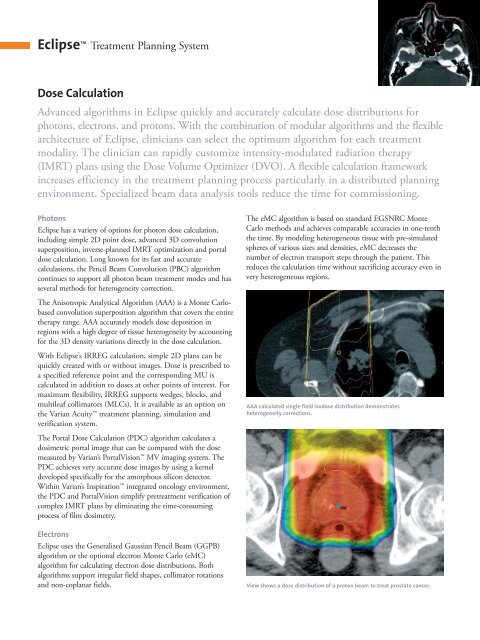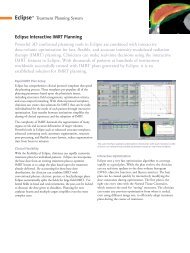Eclipse Dose Calculation - Behestan Darman
Eclipse Dose Calculation - Behestan Darman
Eclipse Dose Calculation - Behestan Darman
You also want an ePaper? Increase the reach of your titles
YUMPU automatically turns print PDFs into web optimized ePapers that Google loves.
<strong>Eclipse</strong> Treatment Planning System<strong>Dose</strong> <strong>Calculation</strong>Advanced algorithms in <strong>Eclipse</strong> quickly and accurately calculate dose distributions forphotons, electrons, and protons. With the combination of modular algorithms and the flexiblearchitecture of <strong>Eclipse</strong>, clinicians can select the optimum algorithm for each treatmentmodality. The clinician can rapidly customize intensity-modulated radiation therapy(IMRT) plans using the <strong>Dose</strong> Volume Optimizer (DVO). A flexible calculation frameworkincreases efficiency in the treatment planning process particularly in a distributed planningenvironment. Specialized beam data analysis tools reduce the time for commissioning.Photons<strong>Eclipse</strong> has a variety of options for photon dose calculation,including simple 2D point dose, advanced 3D convolutionsuperposition, inverse-planned IMRT optimization and portaldose calculation. Long known for its fast and accuratecalculations, the Pencil Beam Convolution (PBC) algorithmcontinues to support all photon beam treatment modes and hasseveral methods for heterogeneity correction.The Anisotropic Analytical Algorithm (AAA) is a Monte Carlobasedconvolution superposition algorithm that covers the entiretherapy range. AAA accurately models dose deposition inregions with a high degree of tissue heterogeneity by accountingfor the 3D density variations directly in the dose calculation.With <strong>Eclipse</strong>’s IRREG calculation, simple 2D plans can bequickly created with or without images. <strong>Dose</strong> is prescribed toa specified reference point and the corresponding MU iscalculated in addition to doses at other points of interest. Formaximum flexibility, IRREG supports wedges, blocks, andmultileaf collimators (MLCs). It is available as an option onthe Varian Acuity treatment planning, simulation andverification system.The Portal <strong>Dose</strong> <strong>Calculation</strong> (PDC) algorithm calculates adosimetric portal image that can be compared with the dosemeasured by Varian’s PortalVision MV imaging system. ThePDC achieves very accurate dose images by using a kerneldeveloped specifically for the amorphous silicon detector.Within Varian’s Inspiration integrated oncology environment,the PDC and PortalVision simplify pretreatment verification ofcomplex IMRT plans by eliminating the time-consumingprocess of film dosimetry.Electrons<strong>Eclipse</strong> uses the Generalized Gaussian Pencil Beam (GGPB)algorithm or the optional electron Monte Carlo (eMC)algorithm for calculating electron dose distributions. Bothalgorithms support irregular field shapes, collimator rotationsand non-coplanar fields.The eMC algorithm is based on standard EGSNRC MonteCarlo methods and achieves comparable accuracies in one-tenththe time. By modeling heterogeneous tissue with pre-simulatedspheres of various sizes and densities, eMC decreases thenumber of electron transport steps through the patient. Thisreduces the calculation time without sacrificing accuracy even invery heterogeneous regions.AAA calculated single field isodose distribution demonstratesheterogeneity corrections.View shows a dose distribution of a proton beam to treat prostate cancer.
<strong>Eclipse</strong> Treatment Planning SystemProtons<strong>Eclipse</strong> Proton Planning uses a unique 3D pencil beamconvolution superposition algorithm for fast and accurate dosecalculations. <strong>Dose</strong> kernels derived from Monte Carlocalculations within the patient are convolved with in-air protonfluences. Consequently, this algorithm is easily adapted for bothdouble-scattering and wobbling beam lines and supports protonaccelerators from a variety of manufacturers. The 3D AnalyticalPencil Beam algorithm accurately models heterogeneities, whichare very important for proton calculations.Rapid OptimizationThe DVO creates highly conformal dose distributions byoptimizing beam intensity profiles according to user-defineddose-volume objectives and the Normal Tissue Constraint. TheDVO uses simple gradient optimization with line minimizationto iteratively modify the field fluences and recalculate the dosedistribution until the desired objectives are reached.Electron Monte Carlo dose distribution is displayed on a sagittal view.During each iteration, <strong>Eclipse</strong> uses the Multi-Resolution <strong>Dose</strong><strong>Calculation</strong> (MRDC) algorithm for a 3D dose calculation thataccounts for full scatter and tissue heterogeneities. The MRDCis based on the 3D convolution of Monte-Carlo-generatedpoint-spread function kernels. Because of the high speed of theMRDC algorithm (a few hundred milliseconds to calculate anIMRT field), the clinician can interact with the optimization inreal-time, rapidly customizing the plan for each patient.After dose optimization, <strong>Eclipse</strong> calculates the leaf motionsneeded to deliver the dose defined by the field fluences. In thiscalculation, <strong>Eclipse</strong> accounts for the physical properties of theMLC and maximizes delivery efficiency while minimizingdeviations from the optimal fluence. With the resulting MLCleaf sequence, the final dose calculation accurately represents thedose delivered by the accelerator.Flexible <strong>Calculation</strong> Framework<strong>Eclipse</strong> uses a flexible dose calculation framework to managecalculation activities across a distributed network. The cliniciancan designate certain workstations within the <strong>Eclipse</strong> networkfor local or remote calculations. The <strong>Eclipse</strong> <strong>Calculation</strong> Queuecomputes dose distributions in the background and stores theresults for later retrieval, thereby freeing the clinician to work onother tasks.With multiple algorithms to choose from, the clinician canselect the one best suited for each clinical case. When newversions of algorithms are released, the physicist can compareversions side-by-side for commissioning. New algorithms can beimplemented as they become available without having toupgrade the entire treatment planning system. Varian hasdeveloped an applications programming interface (API) soresearchers can implement their own algorithms within <strong>Eclipse</strong>.Easy Commissioning<strong>Eclipse</strong> is easy to commission. Configuring photon beams frombasic input data is completely automated for AAA. All <strong>Eclipse</strong>algorithms have minimal beam data measurement requirements.This reduces the labor of collecting basic input data andconfiguring new beam models. The physicist can begin usingnew algorithms quickly and confidently, because the <strong>Dose</strong><strong>Calculation</strong> Framework supports side-by-side algorithmcalculation comparisons.Pre-configured AAA beam models and pre-measured basic inputdata for PBC and GGPB are available for the Varian Clinac® EX(and most C/CD) high-energy linear accelerators. Thissignificantly reduces beam model configuration time. Beam dataanalysis tools in <strong>Eclipse</strong> simplify the validation of beam modelsand calculations. <strong>Eclipse</strong> automatically calculates depth dosecurves and profiles in a water phantom corresponding to eachmeasured input data curve. Comparison data are presented asrecommended by AAPM Task Group 53 on Quality Assurancefor Clinical Radiotherapy Treatment Planning.USA Headquarters, CaliforniaVarian Medical SystemsPalo Alto, CATel: 650.424.5700800.544.4636Fax: 650.493.5637www.varian.comHeadquarters Europe, Eastern Europe, Africa,Middle & Near EastVarian Medical Systems International AGZug, SwitzerlandTel: 41.41.749.8844Fax: 41.41.740.3340info.europe@varian.comRAD7161B © 2006 Varian Medical Systems, Inc. Printed in USA 7/06 (5K)










